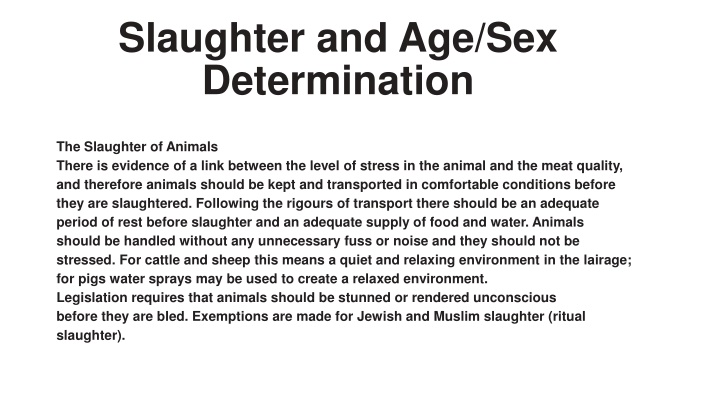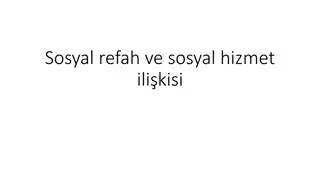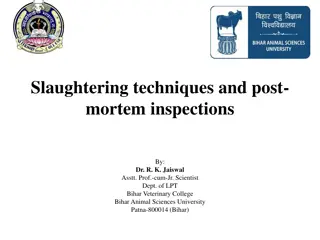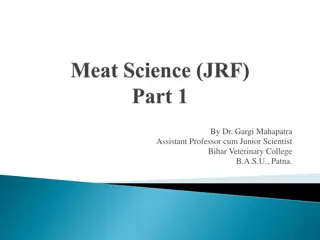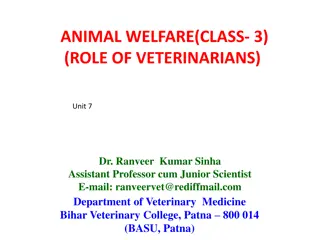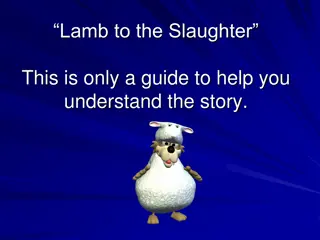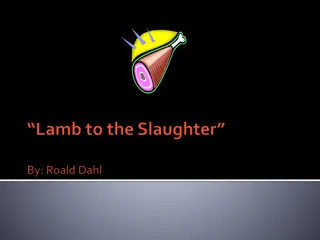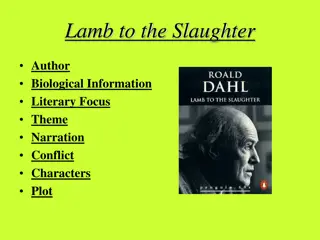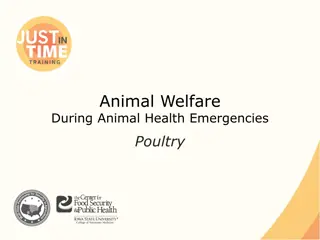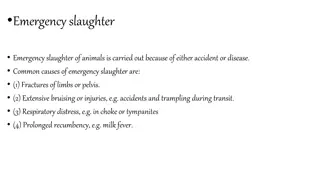Animal Slaughter Methods and Welfare Considerations
Evidence suggests a correlation between animal stress levels and meat quality, emphasizing the importance of comfortable handling, transportation, and slaughter practices. This includes providing rest, food, and water, as well as minimizing stress factors. Stunning methods such as mechanical, electrical, and CO2 stunning are discussed, with details on techniques for different livestock. Ensuring correct stunning procedures is crucial for welfare and meat quality.
Download Presentation

Please find below an Image/Link to download the presentation.
The content on the website is provided AS IS for your information and personal use only. It may not be sold, licensed, or shared on other websites without obtaining consent from the author.If you encounter any issues during the download, it is possible that the publisher has removed the file from their server.
You are allowed to download the files provided on this website for personal or commercial use, subject to the condition that they are used lawfully. All files are the property of their respective owners.
The content on the website is provided AS IS for your information and personal use only. It may not be sold, licensed, or shared on other websites without obtaining consent from the author.
E N D
Presentation Transcript
Slaughter and Age/Sex Determination The Slaughter of Animals There is evidence of a link between the level of stress in the animal and the meat quality, and therefore animals should be kept and transported in comfortable conditions before they are slaughtered. Following the rigours of transport there should be an adequate period of rest before slaughter and an adequate supply of food and water. Animals should be handled without any unnecessary fuss or noise and they should not be stressed. For cattle and sheep this means a quiet and relaxing environment in the lairage; for pigs water sprays may be used to create a relaxed environment. Legislation requires that animals should be stunned or rendered unconscious before they are bled. Exemptions are made for Jewish and Muslim slaughter (ritual slaughter).
Stunning After stunning there are two distinct phases. The first phase is known as the tonic or rigid phase in which the animal falls to the floor and lies still and rigid with its front legs extended and the rear legs retracted towards the body. In the second phase, known as the clonic phase, the animal exhibits uncontrolled convulsions or kicking movements. During both of these phases no rhythmic breathing should be evident. There are three main methods of stunning an animal: (1) Mechanical stunning. (2) Electrical stunning. (3) Carbon dioxide (CO2) stunning.
echanical stunning This method is commonly used on cattle and sheep. Pigs can be stunned by this method; however, this causes excessive convulsions, making it difficult to shackle the legs. Therefore electrical and CO2 stunning tends to be used. There are two types of mechanical stunning device: (1) The invasive captive bolt. (2) The non-invasive captive bolt (knocker).
Both types work by the same principle. A trigger mechanism explodes a blank cartridge, which drives the bolt. It is the velocity of the bolt that is the main factor in providing the required energy for an efficient stun. It is therefore very important that the stunning device be regularly maintained and serviced. The non-invasive or knocker type has a mushroom-shaped end to the bolt. When the bolt hits the skull it stuns the animal. In the invasive type the bolt is driven through the skull into the brain causing invasive damage to the cortex and mid-brain. The animal is rendered incapable of recovery due to the brain damage. To ensure that the animal is stunned correctly it is very important that the correct site for shooting is used. In cattle this is a point on the forehead at the intersection of two imaginary lines drawn from the base of the horns to the eyes on the opposite side. In sheep and domesticated deer the point is at the highest point of the head at the midpoint between the ears and aimed towards the jaw line. In pigs it is about 2.5 cm above the level of the eyes on the mid-line and at right angles to the forehead. In boars and sows it is 5 cm above the level of the eyes and to one side of the mid-line to avoid the maximum thickness of skull bone.
Pithing After cattle are stunned, they are sometimes pithed before bleeding. This is done by inserting a long, thin, flexible metal rod through the hole in the skull made by the bolt of the pistol. It has the effect of destroying the medulla oblongata and therefore minimising reflex muscular action that takes place during sticking and dressing of the carcass. Bleeding is not affected in any appreciable way. Pithing rods must be kept clean and disinfected between use on each animal.
Electrical stunning This consists of passing a 50 Hz electrical current through the brain. This induces a state of immediate epilepsy in the brain during which time the animal is unconscious. The length of time the electrical stun is applied has no effect on the length of the tonic or clonic phases. To ensure a good stun the position of the tongs is crucial. The stun is also dependent on the voltage, the resistance of the animal, the contact area and the pressure applied by the tongs. Some systems will have fail-safe circuitry which passes a low voltage when the tongs are first applied to determine the resistance of the animal. If the resistance measured will allow a stun, then the full voltage will be discharged; if the resistance will not allow a stun, then the full voltage is not discharged. This type of stunning is mainly used for pigs, sheep and calves. It is not particularly satisfactory for sheep due to the insulating effects of the wool and the positioning of the tongs on horned sheep. Bleeding should commence within 5 seconds of stunning or blood splashing may occur. There are also stun-kill devices which stun the animal and cause cardiac arrest at the same time. One such device is the head to back or cardiac arrest stunner. Used mainly for sheep, the electrical contact is improved by water spraying the sheep beforehandand by spraying water over the front head electrodes. Other new types of electrical stunning devices use high-frequency (over 300 Hz) voltages with different or hybrid electrical waves.
Carbon dioxide (CO2) stunning This method is used commonly for pigs. The pigs are passed through a well with a CO2 and air atmosphere. Legally a minimum of a 70% concentration of CO2 by volume is required, but a 90% concentration is recommended. The pigs are rendered unconscious due to the acidification of the cerebrospinal fluid (CSF) upon inhalation of the CO2. The pH of the CSF drops from its normal level of 7.4 to 6.8. The advantage of this method is that blood splashing is eliminated. It also removes the human element required in the electrical stunning.
Bleeding of the animal (exsanguination) (sticking) This is the only procedure that must be assumed to cause the death of the animal: none of the stunning methods can be assumed to have killed the animal. Legally, no other slaughter or dressing procedures should be carried out before the expiry of at least 30 seconds for cattle and 20 seconds for sheep, goats, pigs and deer. Sticking should occur within 15 seconds of stunning. About 40 60% of the total blood volume is lost during bleeding of the animal. The
Cattle After the animal has been stunned and pithed, the skin is incised along the jugular furrow with one knife. A second knife is then used to sever the aorta in the thoracic cavity. The knives should be sterilised between each incision. Bleeding should continue for 5 6 minutes. The average amount of blood obtained from cattle is about 13.5 litres. Sheep Sheep are generally stunned either by a captive bolt pistol or by electricity. If a captive bolt pistol is used, the sheep must be stunned separately and not in the sight of other sheep. Bleeding is done by making an incision in the jugular furrow close to the head and severing the carotid arteries. Bleeding should last for about 5 minutes and the amount of blood obtained is about 2 litres. Pigs In pigs the knife is inserted in the mid-line of the neck in the depression in front of the sternum. The anterior vena cava is then severed at the entrance of the chest. It is important not to puncture the pleura here or back bleeding or oversticking occurs (see p. 175). This is fairly common in pigs because of their short necks. Pigs should be allowed to Deer Domesticated deer are bled in the same way as pigs. The amount of blood obtained varies from 2 4 litres according to size bleed for about 5 minutes. The amount of blood obtained is from 2 4 litres according to size.
Ritual slaughter Legislation allows for the slaughter of animals without previous stunning in the (1) Jewish and (2) Islamic or Muslim methods. The same exemption also applies for the ritual slaughter of poultry. Apart from poultry, only cloven-footed animals that chew the cud are eaten by Jews and Muslims. In their slaughterhouses, therefore, only cattle, sheep and goats are ritually slaughtered. It has been stated frequently that animals bleed better by the Jewish or Muslim method than by other methods, but this is doubtful. There is no scientific evidence that different methods of slaughter have any effect on the efficiency of bleeding. Jews and Muslims use their own licensed slaughtermen.
Jewish method of slaughter Shechita Aswift cut is made across the neck with a very sharp knife. This severs the skin, underlying muscles, trachea, oesophagus, jugular veins and carotid arteries. The five principles of Shechita are that the neck should be cut without pause, pressure, stabbing, slanting or tearing. If the knife receives any nick during the operation the slaughtered animal is considered unfit for Jewish consumption. When the diaphragm is exposed during dressing of the carcass, the shochet or Jewish cutter pierces this and subjects the thoracic organs to a manual examination. This is known as searching . Any adhesions of the lungs found are examined visually, and if deemed detrimental to the animal when it was alive, the carcass is pronounced terefah or unfit for Jewish consumption. Carcasses found fit or Kosher must have the meat porged by removal of the blood vessels and sinews. It is for this reason that the forequarters, which are easily porged, are eaten by Jews. The hindquarters, which are difficult to porge, are seldom eaten by them but are sold to the non-Jewish population who, although they may be opposed to ritual slaughter, may eat suc
Muslim method of slaughter hall This method is similar to the Jewish method, but there is no searching or porging after slaughter and both fore- and hindquarters are eaten.
Rigor mortis After death, rigor mortis occurs. It develops 4 8 hours after slaughter in pigs, 8 12 hours after in sheep and 12 24 hours after in cattle. The pH of the muscle at the time of death is about 7, i.e. neutral. During the process of rigor mortis the glycogen in the muscle turns to lactic acid, causing the muscle to become more acid and the pH falls to 5.5 5.8. Owing to the chemical action taking place there is a rise in temperature of about 3 C in the carcass. The characteristics of rigor mortis are: (1) Contraction and hardening of muscles. (2) Dullness of muscles through lack of transparency. (3) Stiffness and immobility of joints. It is associated with the breakdown of adenosine triphosphate (ATP) and its nonreplacement because of the lack of oxygen. Rigor mortis gradually disappears after 24 hours of its onset. Various factors can affect it. The higher the ambient temperature the quicker are its onset and disappearance. Lower temperatures have the opposite effect. In fevered animals the resulting rigor mortis may be very slight and transient. A low pH is a desirable factor for the keeping quality and tenderness of meat. The hardening of fat after death is due to the fall in temperature and not to rigor mortis.
